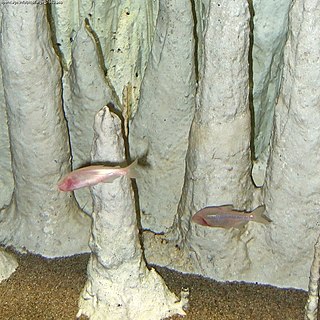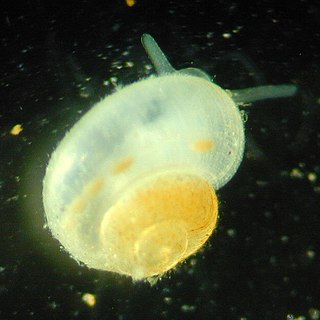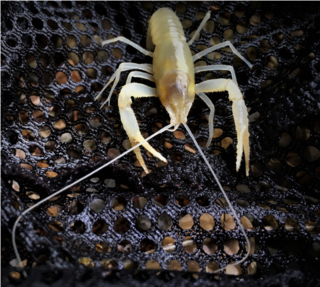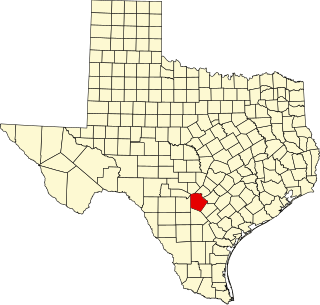
A cave or cavern is a natural void under the Earth's surface. Caves often form by the weathering of rock and often extend deep underground. Exogene caves are smaller openings that extend a relatively short distance underground. Caves which extend further underground than the opening is wide are called endogene caves.

Mole Creek Karst is a national park situated in the North of Tasmania, Australia, 168 km northwest of Hobart. It is located on the slopes of the Great Western Tiers to the east of the town of Mole Creek. It is the only national park in Tasmania created specifically to protect karst landforms. It is part of the Tasmanian Wilderness World Heritage Site.

In biochemistry, chemosynthesis is the biological conversion of one or more carbon-containing molecules and nutrients into organic matter using the oxidation of inorganic compounds or ferrous ions as a source of energy, rather than sunlight, as in photosynthesis. Chemoautotrophs, organisms that obtain carbon from carbon dioxide through chemosynthesis, are phylogenetically diverse. Groups that include conspicuous or biogeochemically important taxa include the sulfur-oxidizing Gammaproteobacteria, the Campylobacterota, the Aquificota, the methanogenic archaea, and the neutrophilic iron-oxidizing bacteria.

Nepidae is a family of exclusively aquatic Heteropteran insects in the order Hemiptera. They are commonly called water scorpions for their superficial resemblance to scorpions, due to their raptorial forelegs and the presence of a long slender process at the posterior end of the abdomen, resembling a tail. There are 14 genera in the family, in two subfamilies, Nepinae and Ranatrinae. Members of the genus Ranatra, the most widespread and species-rich genus, are sometimes called needle bugs or water stick insects as they are slenderer than Nepa.

Elassona is a town and a municipality in the Larissa regional unit in Greece. During antiquity Elassona was called Oloosson (Ὀλοοσσών) and was a town of the Perrhaebi tribe. It is situated at the foot of Mount Olympus. Elassona is bypassed by the GR-3.

Stygofauna are any fauna that live in groundwater systems or aquifers, such as caves, fissures and vugs. Stygofauna and troglofauna are the two types of subterranean fauna. Both are associated with subterranean environments – stygofauna are associated with water, and troglofauna with caves and spaces above the water table. Stygofauna can live within freshwater aquifers and within the pore spaces of limestone, calcrete or laterite, whilst larger animals can be found in cave waters and wells. Stygofaunal animals, like troglofauna, are divided into three groups based on their life history - stygophiles, stygoxenes, and stygobites.
- Stygophiles inhabit both surface and subterranean aquatic environments, but are not necessarily restricted to either.
- Stygoxenes are like stygophiles, except they are defined as accidental or occasional presence in subterranean waters. Stygophiles and stygoxenes may live for part of their lives in caves, but don't complete their life cycle in them.
- Stygobites are obligate, or strictly subterranean, aquatic animals and complete their entire life in this environment.

Troglofauna are small cave-dwelling animals that have adapted to their dark surroundings. Troglofauna and stygofauna are the two types of subterranean fauna. Both are associated with subterranean environments – troglofauna are associated with caves and spaces above the water table and stygofauna with water. Troglofaunal species include spiders, insects, myriapods and others. Some troglofauna live permanently underground and cannot survive outside the cave environment. Troglofauna adaptations and characteristics include a heightened sense of hearing, touch and smell. Loss of under-used senses is apparent in the lack of pigmentation as well as eyesight in most troglofauna. Troglofauna insects may exhibit a lack of wings and longer appendages.

The Ayalon Cave is a large limestone cave near Ramla, Israel, with a worldwide unique ecosystem. As photosynthesis is not possible inside the completely dark cave, the food chain that developed inside is solely based on bacteria capable of chemosynthesis: the bacteria are consuming the anorganic matter available in the groundwater, and then themselves become the organic food source for the rest of the food chain. As of 2021, Ayalon Cave was one of less than 10 such subterranean ecosystems known in the world, with each of them being distinctly different from the rest. Eight new invertebrate species were discovered there in April 2006 - four seawater and freshwater crustaceans along with four terrestial animals, one of them a species of blind scorpion – with many more expected to be discovered.

Villa Luz Cave, Spanish name Cueva de Villa Luz, also known as Cueva del Azufre and Cueva de las Sardinas, is a cave near Tapijulapa in the southern Mexican state of Tabasco. The springs within the cave are rich in hydrogen sulfide, a gas that is a potent respiratory toxicant and smells like rotten eggs. Within the water sulfide is oxidized to colloidal sulfur which gives the water a milky appearance, and creates sulfuric acid. The cave is essentially a maze about two kilometers in length and primarily etched out of limestone by the sulfuric acid in the water. Hydrogen sulfide is also used by chemoautotrophic bacteria, which form the base of the food web.
Cave-dwelling insects are among the most widespread and prominent troglofauna, including troglobites, troglophiles, and trogloxenes. As a category of ecological adaptations, such insects are significant in many senses, ecological, evolutionary, and physiological.

The Tumbling Creek cavesnail is a species of freshwater cave snail with gills and an operculum, an aquatic gastropod mollusk in the family Amnicolidae.

Cambarus zophonastes, also known as the Hell Creek Cave crayfish, is named for its original location of discovery, Hell Creek Cave. It is also found in other similar habitats in Stone County and Marion County, Arkansas. These habitats include springs and caves such as Nesbitt Spring Cave in Stone County. C. zophanastes is critically endangered according to the IUCN. C. zophanastes is also protected by the ESA as an endangered species. Currently conservation efforts focus on monitoring populations, reducing disturbances, and monitoring water quality. More research has to be conducted to better understand and conserve the species.
Lirceus usdagalun is a rare species of crustacean known by the common name Lee County cave isopod. It is endemic to Virginia in the United States, where it is known from a single network of karst cave systems in Lee County. It is threatened by a number of processes. It is a federally listed endangered species of the United States, and is assessed as "endangered" by the International Union for Conservation of Nature.
Movile Cave is a cave near Mangalia, Constanța County, Romania discovered in 1986 by Cristian Lascu a few kilometers from the Black Sea coast. It is notable for its unique groundwater ecosystem abundant in hydrogen sulfide and carbon dioxide, but low in oxygen. Life in the cave has been separated from the outside for the past 5.5 million years and it is based completely on chemosynthesis rather than photosynthesis.
Texella reddelli, the Bee Creek cave harvestman, is a rare species of troglobitic harvestman that was added to the United States endangered species list in 1988, at the same time as six other species native to the karst ecosystem in Travis County and Williamson County, Texas, USA. They inhabit areas with near 100% humidity and constant temperatures, and they prey on springtails. Research on these creatures has been difficult since they can only be found underground. Their distribution is limited and unknown reproductive rates mean that it is possible they are especially susceptible to habitat destruction and other threats. Texella reddelli are found on both the North and South sides of the Colorado River.

The Kretschmarr Cave mold beetle is a small mold beetle.

Nepa is a genus belonging to the family Nepidae, known as water scorpions. There are six species found in freshwater habitats in the Northern Hemisphere.

Kryptonesticus is a genus of European scaffold web spiders first described by Pavlek & Ribera in 2017, based around the newly described type species Kryptonesticus deelemanae and seven species transferred from genus Nesticus. In 2018, an additional species, K. georgescuae, was described from two female specimens from Romania.

Rhadine infernalis is a species of troglobitic beetle of the family Carabidae. They are endemic to the county of Bexar, Texas. Within this county, R. infernalis has been found in 39 caves. There are 2 named subspecies of R. infernalis: R. infernalis infernalis and R. infernalis ewersi. There is a third possible subspecies that has not been officially described. R. infernalis was classified in 2000 as endangered under the IUCN Endangered Species Act of 1973, along with 8 other karst invertebrates in the same region. It has the widest known range of the endangered karst invertebrates.















